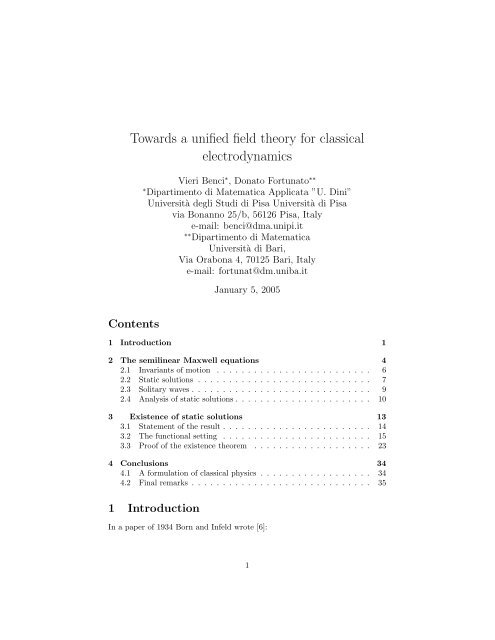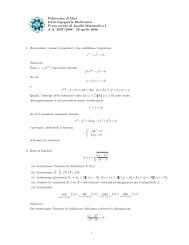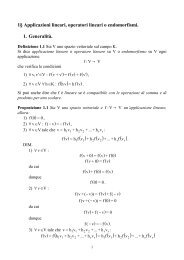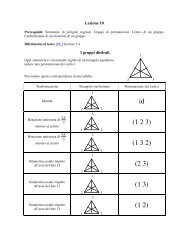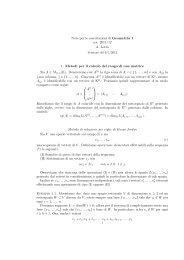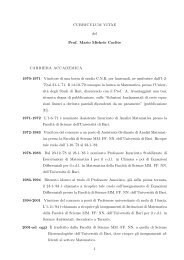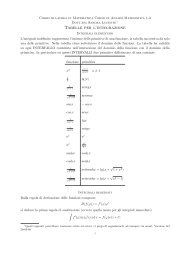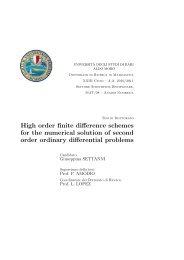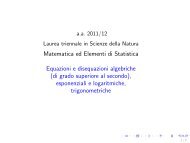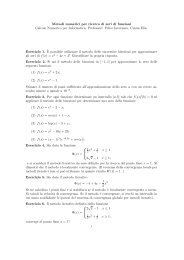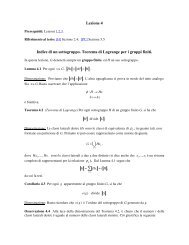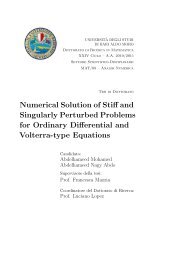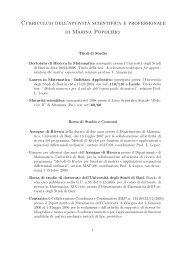Towards a unified field theory for classical electrodynamics
Towards a unified field theory for classical electrodynamics
Towards a unified field theory for classical electrodynamics
- No tags were found...
Create successful ePaper yourself
Turn your PDF publications into a flip-book with our unique Google optimized e-Paper software.
<strong>Towards</strong> a <strong>unified</strong> <strong>field</strong> <strong>theory</strong> <strong>for</strong> <strong>classical</strong><strong>electrodynamics</strong>Vieri Benci ∗ , Donato Fortunato ∗∗∗ Dipartimento di Matematica Applicata ”U. Dini”Università degli Studi di Pisa Università di Pisavia Bonanno 25/b, 56126 Pisa, Italye-mail: benci@dma.unipi.it∗∗ Dipartimento di MatematicaUniversità di Bari,Via Orabona 4, 70125 Bari, Italye-mail: <strong>for</strong>tunat@dm.uniba.itJanuary 5, 2005Contents1 Introduction 12 The semilinear Maxwell equations 42.1 Invariants of motion . . . . . . . . . . . . . . . . . . . . . . . . . 62.2 Static solutions . . . . . . . . . . . . . . . . . . . . . . . . . . . . 72.3 Solitary waves . . . . . . . . . . . . . . . . . . . . . . . . . . . . . 92.4 Analysis of static solutions . . . . . . . . . . . . . . . . . . . . . . 103 Existence of static solutions 133.1 Statement of the result . . . . . . . . . . . . . . . . . . . . . . . . 143.2 The functional setting . . . . . . . . . . . . . . . . . . . . . . . . 153.3 Proof of the existence theorem . . . . . . . . . . . . . . . . . . . 234 Conclusions 344.1 A <strong>for</strong>mulation of <strong>classical</strong> physics . . . . . . . . . . . . . . . . . . 344.2 Final remarks . . . . . . . . . . . . . . . . . . . . . . . . . . . . . 351 IntroductionIn a paper of 1934 Born and Infeld wrote [6]:1
The relation of matter and the electromagnetic <strong>field</strong> can be interpretedfrom two opposite standpoints:The first which may be called the unitarian standpoint assumesonly one physical entity, the electromagnetic <strong>field</strong>. The particlesof matter are considered as singularities of the <strong>field</strong> and mass isa derived notion to be expressed by <strong>field</strong> energy (electromagneticmass).The second or dualistic standpoint takes <strong>field</strong> and particle as twoessentially different agencies. The particles are the sources of the<strong>field</strong>, are acted on by the <strong>field</strong> but are not a part of the <strong>field</strong>; theircharacteristic property is inertia measured by a specific constant,the mass.Then they report physical and phylosophical reasons to explain the advantagesof the unitarian standpoint.They present a unitary <strong>field</strong> <strong>theory</strong> based on a new <strong>for</strong>mulation of theMaxwell equations; they replace the usual Lagrangian density of the electromagnetic<strong>field</strong> E, HL = 1 (E 2 − H 2) (1)2with a modified LagrangianL = 1 − √ 1 − (E 2 − H 2 ) = 1 2(E 2 − H 2) + o ( E 2 − H 2) (2)They claim to have found nontrivial static solutions of the Euler-Lagrangeequation associated to the Lagrangian (2). Actually they made a mistake and,recently, it has been proved that there are not such solutions (<strong>for</strong> a proof see[11]).However we think that the motivations <strong>for</strong> a new <strong>for</strong>mulation of Maxwellequations are still valid. Nowadays, the methods of nonlinear analysis are sufficientlystrong to analyse unitarian <strong>field</strong>s theories derived by perturbations ofLagrangian (1). In this paper we present a unitarian <strong>field</strong> <strong>theory</strong> based on aperturbation of (1). This perturbation produces a semilinear modification ofthe Maxwell equations.Our <strong>theory</strong> presents the following peculiarities:• matter particles are not singularities of the <strong>field</strong> but solitary waves due tothe presence of nonlinearities; thus particles have space extension;• the equations are invariant <strong>for</strong> the Poincaré group; then the basic principlesof special relativity <strong>theory</strong> hold; in particular inertial mass equalsenergy;• the energy of particles is finite: this point is very important, since it impliesfinite particle mass and makes <strong>electrodynamics</strong> consistent. In the usualapproach to <strong>classical</strong> <strong>electrodynamics</strong>, particles are points with infiniteinertial mass. This fact gives rise to well known difficulties (see <strong>for</strong> examplech. 17 of [8], sections 37, 75 of [9] or ch. 8 in [10]).2
• the total charge is a constant of motion and its value depends on the initialconditions.• any matter particle carries a magnetic moment; this is a kind of <strong>classical</strong>analogous of the spin.• by the presence of the nonlinear term the equations of this <strong>theory</strong> are notgauge invariant. We point out that the gauge invariance is destroyed onlyin the region where the solitary wave is ”concentrated” ( the matter ) andit is preserved in the region where the nonlinear term is negligible so thatthere we have essentially the Maxwell equations in the empty space.• this model deals with <strong>classical</strong> <strong>electrodynamics</strong> without touching any questionsrelated to quantum <strong>theory</strong>.In the following we briefly sketch the content of the paper and the mainmathematical features.In section 2, we introduce a semilinear perturbation of Maxwell equations(SME) and describe the general characteristics of the resulting equations. Wecannot exhibit explicit static solutions of SME and their existence is provedby using a suitable variational approach. In particular, in section 3, we studythe magnetostatic case (i.e. the case in which the electric <strong>field</strong> E = 0 and themagnetic <strong>field</strong> H does not depend on time). In this case SME are reduced tothe nonlinear elliptic degenerate equation∇ × ∇ × A = f ′ (A) (3)where ∇× denotes the curl operator, f ′ is the gradient of a strictly convexsmooth function f: R 3 → R and A : R 3 → R 3 is the gauge potential related tothe magnetic <strong>field</strong> H (H = ∇ × A).The main difficulty in dealing with the above equation relies in the fact thatthe energy related to it∫ ( )1E(A) =2 |∇ × A|2 − f (A) dx (4)does not yield a priori bound on ‖∇A‖ L 2 . In particular the functional (4) isstrongly indefinite in the sense that it is not bounded from above or from belowand any possible critical point A has infinite Morse index; namely, the secondvariation of (4)∫ ( )E ′′ (A) [v, v] = |∇ × v| 2 − f ′′ (A) [v, v] dxis negative definite on the infinite dimensional subspace{v = ∇ϕ : ϕ ∈ C∞0(R 3 , R )} .3
On the other hand, the nonlinearity f ′ (A) destroys the gauge invariance of (3).So it is not possible to choose the Coulomb gauge (where ∇ · A = 0) to avoidthis indefiniteness.Another difficulty arises from the growth conditions of the nonlinearityf ′ (A). In fact, physical considerations (see section 2) impose f ′ (A) to be negligeablewhen | A | is small (see W1), namely f ′′ (0) = 0. This fact leads tostudy the problem in the funcion spaceD :={u ∈ L 6 :∫}|∇u| 2 dx < +∞and in the Orlicz space L p + L q (1 < p < 6 < q) in which D is continuouslyembedded (see (60)).We will use a min-max argument. Strongly indefinite functional have beenlargely considered in relation to other problems arising in mathematical physicsand treated with min-max methods; we recall just few of them: periodic solutionsof Hamiltonian system [3], Lorentzian geometry [1], Dirac equation [7].By its nature, (4) cannot be studied by a direct application of the theories previuoslydeveloped and a new approach is required. In particular we will use anew functional framework related to the Hodge splitting of the vector <strong>field</strong> A.The last section is devoted to final considerations.AcknowledgmentsWe thank Marino Badiale and Charles Stuart <strong>for</strong> their useful suggestions.2 The semilinear Maxwell equationsThe Maxwell equations in the empty space are the Euler-Lagrange equations ofthe following action functionalS = − 1 ∫〈dξ, dξ〉 ω (5)2Hereξ =3∑A i dx i + ϕdti=1A i , ϕ : R 4 → Ris the gauge potential 1-<strong>for</strong>m in the space-time R 4 , dξ denotes the exteriorderivative, ω is the volume <strong>for</strong>m and〈dξ, dξ〉 = ∗ (∗dξ ∧ dξ)where ∗ is the Hodge operator with respect to the Minkowski metric in R 4 .More explicitly, S can be written as follows:S = 1 ∫ ∫ [ ∣ ∣ ]∣∣∣ ∂A ∣∣∣22 ∂t +∇ϕ − |∇ × A| 2 dxdt (6)4
where A = (A 1 , A 2 , A 3 ).We modify the action (6) in the following way:S = 1 2∫ ∫ [ ∣ ∣ ∣∣∣ ∂A ∣∣∣2(∂t +∇ϕ − |∇ × A| 2 + W |A| 2 − ϕ 2)] dxdt (7)where W : R → R.The argument of W is |A| 2 − |ϕ| 2 to make this expression invariant <strong>for</strong> thePoincaré group and the equations consistent with special relativity.Making the variation of S with respect to δA, δϕ respectively, we get theequations( )∂ ∂A(∂t ∂t + ∇ϕ + ∇ × (∇ × A) = W ′ |A| 2 − ϕ 2) A (8)( ) ∂A( −∇ ·∂t +∇ϕ = W ′ |A| 2 − ϕ 2) ϕ (9)If we setwe get the equations:H = ∇ × A (10)E = − ∂A −∇ϕ (11)∂tρ = W ′ ( |A| 2 − ϕ 2) ϕ (12)J = W ′ ( |A| 2 − ϕ 2) A (13)∇ × H − ∂E = J (A, ϕ)∂t(14)∇ · E = ρ (A, ϕ) (15)∇ × E + ∂H∂t = 0 (16)∇ · H = 0 (17)which, <strong>for</strong>mally, are the Maxwell equations in the presence of matter if weinterpret ρ (A, ϕ) as the charge density and J (A, ϕ) as the current density.Notice that ρ and J are functions of the gauge potentials, so that we are in thepresence of a <strong>unified</strong> <strong>theory</strong> in the sense of Born-Infeld. Hereafter the system(8), (9) (or (14),...,(17)) will be called SME.We now make the following assumption on W :• (W1) there exsist two positive constants ε 1 , ε 2 ≪ 1|W ′ (t)| ≤ ε 1 |t| <strong>for</strong> |t| ≤ 1; (18)|W ′ (t)| ≥ 1 <strong>for</strong> |t| ≥ 1 + ε 2 (19)5
We setΩ t (A, ϕ) ={x ∈ R 3 ∣: ∣|A (x, t)| 2 − ϕ (x, t) 2∣ }∣ ≥ 1Ω t represents the portion of space filled with matter at time t. Assumption (18)implies that ρ and J become negligible outside Ω t and the above equations canbe interpreted as the Maxwell equations in the empty space.Assumption (19) implies that ρ and J become strong inside Ω t , at least in∣the region where ∣|A (x, t)| 2 − ϕ (x, t) 2∣ ∣ ≥ 1 + ε2 .2.1 Invariants of motionIn this section, we will assume that SME have sufficiently smooth solutionsand we will analyse some of their properties. Also we will assume that thesesolutions are sufficienltly small at infinity in such a way that we can per<strong>for</strong>mintegrations by part with null ”boundary” terms. The main invariants of themotion of SME, namely the energy and the momentum can be calculated byusing Noether’s theorem. A direct calculation shows that they have the followingexpressions:• Energy:E (A, ϕ) = 1 2∫ ( ∣ ∣∣∣ ∂A∂t∣2− |∇ϕ| 2 + |∇ × A| 2 − W(|A| 2 − ϕ 2)) dx(20)• Momentum:∫P (A, ϕ) =3∑i=1( ∂Ai∂t + ∂ϕ )∇A i dx (21)∂x iAnother invariant is the• Charge:∫C (A, ϕ) =∫ρ (A, ϕ) dx =W ′ ( |A| 2 − ϕ 2) ϕdx (22)In fact, if we take the divergence in (14) and the derivative with respect to t in(15), we easily get the continuity equation∂ρ∂t + ∇ · J =0We can express the energy by a more meaningful expression which will beuseful later:6
Proposition 1 The energy of the solutions of SME is∫ ( 1E (A, ϕ) =2 |E|2 + 1 2 |H|2 − W ′ (σ) ϕ 2 − 1 )2 W (σ) dx= 1 ∫ (|E| 2 + |H| 2) ∫dx −(ρϕ + 1 )22 W (σ) dxwhereσ = |A| 2 − ϕ 2Proof. If we multiply Eq. (15) by ϕ and integrate in x we get∫ ( ) ∫∂A∂t · ∇ϕ + |∇ϕ|2 dx − W ′ (σ) ϕ 2 dx = 0;We add this expression to E (A, ϕ) ; then∫ ( )21E (A, ϕ) =∂A2 ∣ ∂t ∣ + 1 2 |∇ϕ|2 + ∇ϕ · ∂A∂t + 1 2 |∇ × A|2 − W ′ (σ) ϕ 2 − 1 2 W (σ) dx∫ ( ∣ )1=∂A ∣∣∣22 ∣ ∂t +∇ϕ + 1 2 |∇ × A|2 − W ′ (σ) ϕ 2 − 1 2 W (σ) dx∫ ( 1=2 |E|2 + 1 2 |H|2 − W ′ (σ) ϕ 2 − 1 )2 W (σ) dxThe second expression <strong>for</strong> the energy is obtained just using (12)□The term1(|E|2∫R 2 + |H| 2) dx3represents the energy of the electromagnetic <strong>field</strong>, while( )1−∫R 2 W (σ) + W ′ (σ)ϕ 2 dx = −(ρϕ +∫R 1 )2 W (σ) dx (23)3 3represents the energy of the matter (short range <strong>field</strong> such as the nuclear<strong>field</strong>s). It can be interpreted as bond energy and it is ”concentrated” essentiallyin Ω t2.2 Static solutionsIn this section we are interested in the static solutions of (8), (9), namely inthe solutions A, ϕ, depending only on the space variable x, of the followingequations:∇ × (∇ × A) = W ′ ( |A| 2 − ϕ 2) A (24)−∆ϕ = W ′ ( |A| 2 − ϕ 2) ϕ (25)7
The static solutions are critical points of the energy functional:E (A,ϕ) = 1 ∫ ( (|∇ × A| 2 − |∇ϕ| 2 − W |A| 2 − ϕ 2)) dx (26)2Proposition 2 If (A,ϕ) is a finite energy, static solution of SME, thenE (A,ϕ) = 1 3∫=∫ (|∇ × A| 2 − |∇ϕ| 2) dxW(|A| 2 − ϕ 2) dxProof. Letϕ λ (x) = ϕ(λ −1 x);A λ (x) = A(λ −1 x);then, setting y = λ −1 xE (A λ ,ϕ λ ) = 1 ∫ (|∇ x × A λ (x)| 2 − |∇ x ϕ λ (x)| 2) dx − 1 ∫W22= λ ∫ (|∇ y × A (y)| 2 − |∇ y ϕ (y)| 2) ∫dy − λ3W22(|A λ (x)| 2 − ϕ λ (x) 2) dx(|A (y)| 2 − ϕ (y) 2) dySince u is a critical point of E (A λ ,ϕ λ ) ,ddλ E (A λ,ϕ λ )∣ = 0 (27)λ=1Let us compute this expression explicitly:ddλ E (A λ,ϕ λ ) = 1 ∫|∇ y × A (y)| 2 −|∇ y ϕ(y)| 2 dy− 3 ∫22 λ2 WFor λ = 1, using (27), we get∫1 (|∇ × A| 2 − |∇ϕ| 2) ∫dx = W3ThenE (A,ϕ) = 1 2∫ (|∇ × A| 2 − |∇ϕ| 2) dx − 1 2(|A (y)| 2 − ϕ (y) 2) dy(|A| 2 − ϕ 2) dx (28)∫W(|A| 2 − ϕ 2) dx= 1 3∫ (|∇ × A| 2 − |∇ϕ| 2) dxAnd by (28) we have also∫E (A,ϕ) =W(|A| 2 − ϕ 2) dx□8
2.3 Solitary wavesA solitary wave is a solution of a <strong>field</strong> equation whose energy travels as a localizedpacket. Since our equation is invariant <strong>for</strong> the action of the Poincaré group, givena static solution(A (x) ,ϕ (x))it is possible to produce a solitary wave, moving with velocity v = (v, 0, 0), justmaking a Lorentz trans<strong>for</strong>mation:[ ] [ ]Av (x,t) A=′ (x ′ (x,t))ϕ v (x, t) ϕ ′ (x ′ (29)(x,t))where⎡x ′ = ⎣x 1−vt√1−v 2x 2x 3⎤ ⎡⎦ ; A ′ = ⎣A 1+ϕt√1−v 2A 2A 3⎤⎦ ; ϕ ′ = ϕ + A 1t√1 − v2Solitary waves have a particle-like behaviour. In particular, if (A, ϕ) is astatic solution with radial symmetry (whose existence will be proved in thenext section ), the region filled with matterΩ ={x ∈ R 3 :∣∣|A (x)| 2 − ϕ (x) 2∣ ∣ ∣ ≥ 1}is a ball centered at the origin. Making the above Lorentz trans<strong>for</strong>mation{Ω t = x ∈ R 3 ∣: ∣|A v (x, t)| 2 − ϕ v (x, t) 2∣ }∣ ≥ 1becomes a rotation ellipsoid moving in direction x 1 with velocity v and havingthe shortest axis of lenght R √ 1 − v 2 (where R is the radius of Ω). If we let thenonlinear termW (t) = W ε (t) := 1 ε 2 W 1(t)depend on a small parameter ε, then the radius of Ω becomes εR. Letting ε → 0,the particles approach a pointwise behaviour.Moreover the solitary waves obtained by this method present the followingfeatures:• It can be directly verified that the momentum P(A v, ϕ v ) in (21) of thesolitary wave (29) is proportional to the velocity vP(A v, ϕ v ) = mv, m > 0So the constant m defines the inertial mass of (29). Moreover, if wecalculate the energy E(A v, ϕ v ) (20) of (29), it can be seen thatm = E(A v, ϕ v )(Einstein equation; in our model we have set c = 1).9
• the mass increases with velocitym = m 0√1 − v2wherem 0 = E(A, ϕ) = 1 3∫ (|∇ × A| 2 − |∇ϕ| 2) dx =∫W(|A| 2 − ϕ 2) dxis the rest mass.• the solitary wave (29) in a given exterior <strong>field</strong> E, H experiences a <strong>for</strong>ce F(Lorentz <strong>for</strong>ce)F = e (E + v × H)where e is the charge (22)∫ ( )e = W ′ |A v | 2 − ϕ 2 v ϕ v dx.Concluding, our solitary waves behave as relativistic particles except thatthey have space extension. These facts are a consequence of the invariance of theLagrangian density with respect to the Poincaré group and simple computations.For more details on this matter, we refer to a paper in preparation ([2]). Inthe present work, we are interested to discuss the existence of solitary waveswhich is a problem involving techniques of calculus of variation and of nonlinearfunctional analysis.2.4 Analysis of static solutionsIn order to get the simplest static solutions, we make the following ansatz:• ϕ ≠ 0; A = 0;• ϕ = 0; A ≠ 0;With these ansatz, we obtain the following equations:• electrostatic equation:−∆ϕ = W ′ ( −ϕ 2) ϕ (30)• magnetostatic equation:∇ × (∇ × A) = W ′ ( |A| 2) A (31)10
They correspond to the critical points respectively of the functionalsE (ϕ) = − 1 ∫ (|∇ϕ| 2 + W ( −ϕ 2)) dx2E (A) = 1 ∫ ( (|∇ × A| 2 − W |A| 2)) dx (32)2In order to get solutions we need the following technical assumptions:• (W2) there exist positive constants c 2 , c 3 > 0 such thatWe have the following result:|W ′ (t)| ≤ c 2 |t| p/2−1 ; p < 6 <strong>for</strong> |t| ≥ 1|W ′ (t)| ≤ c 3 |t| q/2−1 ; q > 6 <strong>for</strong> |t| ≤ 1Theorem 3 Assume that W satisfies (W2). Then (30) possesses a finite energy,nontrivial solution if and only if there exists t 0 such thatW (t 0 ) < 0 (33)Proof. Since W satisfies (W2) and (33), the if part follows from theorem 4in [4]. The only if part follows from the Pohozaev identity (see prop. 1 in [4]).□Un<strong>for</strong>tunately, by proposition 2, the energy (rest mass) of the solutions of(30)E (ϕ) = − 1 ∫∫|∇ϕ| 2 dx = W ( −ϕ 2) dx3is negative; they are not physically acceptable <strong>for</strong> our program.Thus, if we want to avoid negative energy solutions, we are <strong>for</strong>ced to assume• (W + )W (t) ≥ 0 (34)More exactly we have the followingProposition 4 Assume that W satisfies (W + ) and let (A, ϕ) be a finite energy,non trivial solution of the system (24,25) then:• (i) A(x) ≠ 0• (ii) the total energy E (A,ϕ) in (26) is positive;• (iii) the bond energy (23) is negative.11
Proof. A(x) ≠ 0 is a consequence of Theorem 3. In fact, arguing bycontradiction, assume that A = 0. Then ϕ solves (30). So, since W satisfies(34), by theorem 3 we get that also ϕ = 0. This contradicts the assumption that(A, ϕ) is nontrivial.Since W (t) ≥ 0,by Prop. 2 we deduce that the total energy E (A,ϕ) ispositive . Consider now the bond energy∫−(ρ(σ)ϕ + 1 )2 W (σ) dx,σ = |A| 2 − ϕ 2 , ρ(σ) = W ′ (σ) ϕNow, ∫ W (σ) dx is positive by (34); moreover by (25) we easily derive∫∫∫ρ(σ)ϕdx = W ′ (σ)ϕ 2 dx = |∇ϕ| 2 dx ≥ 0□Remark 5 The property (i) of the above proposition implies that any staticsolution carries a magnetic moment, even when ϕ = 0. Thus any ”particle”is sensitive to external magnetic <strong>field</strong> even if it has no charge. This can beinterpreted as the <strong>classical</strong> analogous of the spin.Remark 6 The property (iii) of the above proposition suggests that solitarywaves must have some <strong>for</strong>m of stability. It is an interesting open problem toinvestigate the orbital stability of them.In the following we shall prove the existence of static solutions when W ≥ 0.In order to get solutions we need to make some other technical assumptions:• (W3) There are constants M 1 and M 2 such thatW (t) ≥ M 1 |t| p/2 ; 2 < p < 6 <strong>for</strong> |t| ≥ 1W (t) ≥ M 2 |t| q/2 ; q > 6 <strong>for</strong> |t| ≤ 1• (W4) W ∈ C 2 andW ′′ (t) > 0 <strong>for</strong> t ≠ 0Clearly (W3) imply (W + ). Moreover, given ε 1 ε 2 > 0, it is possible to choosesuitable constants in (W3) and (W2) such that (W1) holds.We have the following resultTheorem 7 If (W2), (W3) and (W4) hold, then eq. (31) has a nontrivial,finite energy solution. This solutions has radial symmetry, namelyA(x) = g −1 A(gx) ∀g ∈ O(3)where O(3) is the orthogonal group in R 3 .12
The proof of above theorem is quite involved and it is the main result ofsection 3. Here we give an heuristic argument of the proof. Any possible criticalpoint of (32) has infinite Morse index; namely, the second variationE ′′ (A) [v] 2 =∫ (|∇ × v| 2 − W ′ ( |A| 2) |v| 2 − 2W ′′ ( |A| 2) (A·v) 2) dxis negative definite on the infinite dimensional subspace{v = ∇ϕ : ϕ ∈ C ∞ 0 } ;so the usual tools of critical point <strong>theory</strong> cannot be used. On the other hand,it is not possible to work in the Coulomb gauge (∇ · A = 0) since the nonlinearterm of the functional is not gauge invariant. To avoid this difficulty, we splitany radial the vector <strong>field</strong> A : R 3 → R 3 as followsA = u + v = u + ∇w (35)where u : R 3 → R 3 is a divergence free vector <strong>field</strong> (∇·u = 0) and v : R 3 → R 3is a potential vector <strong>field</strong> v = ∇w (w scalar <strong>field</strong>). Since W is strictly convex,<strong>for</strong> every u with ∇ · u = 0, we can find w 0 which minimises the functional∫w ↦→ W(|u + ∇w| 2) dxand set w 0 = Φ (u) . Replacing (35) in (32) with w = Φ (u) , we get a newfunctionalJ(u) := E (u, Φ (u)) = 1 ∫ ( (|∇u| 2 − W |u + ∇Φ (u)| 2)) dx2which depends only on u. This functional has the Mountain Pass geometry.Then, we expect the existence of a nontrivial critical point u 0 . Now, if J andthe map u → Φ (u) were sufficiently smooth in suitable function spaces, the <strong>field</strong>A = u 0 + ∇ [Φ (u 0 )]would solve equation (30). However, the lack of smoothness does not allow tocarry out a rigorous simple proof directly and the next section 3 will be devotedto the proof of the existence result.Remark 8 It is still an open question to prove the existence of solutions of(24,25) with ϕ ≠ 0 under the assumption W ≥ 0.3 Existence of static solutionsThis section is devoted to the proof of Th.7. The result will be proved in aslightly more general settings which will be stated in the following two subsections.13
3.1 Statement of the resultLet f : R 3 → R be a C 2 function satisfying the following assumptions:f(0) = 0 and f strictly convex (36)There are positive constants c 1 , c 2 , p, q with 2 < p < 6 < q such thatc 1 |ξ| p ≤ f(ξ) <strong>for</strong> |ξ| ≥ 1 (37)c 1 |ξ| q ≤ f(ξ) <strong>for</strong> |ξ| ≤ 1 (38)|f ′ (ξ)| ≤ c 2 |ξ| p−1 <strong>for</strong> |ξ| ≥ 1 (39)|f ′ (ξ)| ≤ c 2 |ξ| q−1 <strong>for</strong> |ξ| ≤ 1 (40)We are interested in finding nontrivial, finite energy, weak solutions A : R 3 →R 3 of the following equation∇ × ∇ × A = f ′ (A) (41)where f ′ denotes the gradient of f.A weak solution of (41) means that both A and f ′ (A) are in L 1 locand <strong>for</strong>all ϕ ∈ C0 ∞ (R 3 , R 3 )∫ ∫(A |∇ × (∇ × ϕ))dx = (f ′ (A) | ϕ) dxwhere (· | ·) denotes the Euclidean inner product in R 3 .Moreover we recall that the energy of a weak solution A of (41) is (see (32))E (A) = 1 ∫∫|∇ × A| 2 dx − f(A)dx (42)2So A has finite energy if∫|∇ × A| 2 dx < ∞,∫f(A)dx < ∞In this case, by proposition 2, we haveE (A) = 1 ∫∫|∇ × A| 2 dx = 23f(A)dx (43)The following theorem holdsTheorem 9 If f satisfies assumptions (36), (37), (38), (39) and (40), equation(41) has at least a nontrivial, weak solution having finite and positive energy.Moreover this solution has radial symmetry, namelyCleary, if we settheorem 7 follows from theorem 9.A(x) =g −1 A(gx) <strong>for</strong> all g ∈ O(3)f (ξ) = 1 2 W (|ξ| 2)14
3.2 The functional settingThe vector <strong>field</strong> A : R 3 → R 3 in (41) is regarded as sumA = u + v = u + ∇w (44)where u : R 3 → R 3 is a divergence free vector <strong>field</strong> (∇ · u = 0) and v : R 3 → R 3is a potential vector <strong>field</strong> v = ∇w, (w scalar <strong>field</strong>).Let D(R 3 , R 3 ) ( D(R 3 , R)) be the completion of C0 ∞ (R 3 , R 3 ) (C0 ∞ (R 3 , R))with respect to the norm(∫‖u‖ D= |∇u| 2 dxR 3) 12Now (39), (40) with assumptions (37) and (38) imply thatc 1 |ξ| p ≤ f(ξ) ≤ c 3 |ξ| p ; <strong>for</strong> |ξ| ≥ 1 (45)c 1 |ξ| q ≤ f(ξ) ≤ c 3 |ξ| q ; <strong>for</strong> |ξ| ≤ 1 (46)So f (ξ) ≃ |ξ| p <strong>for</strong> |ξ| ≥ 1 and f (ξ) ≃ |ξ| q <strong>for</strong> |ξ| ≤ 1 and the choice of thefunction space <strong>for</strong> w is related to these growth properties of f. Consider firstthe space L p + L q made up by the vector <strong>field</strong>s v : R 3 → R 3 such thatv = v 1 + v 2 , with v 1 ∈ L p , v 2 ∈ L q and 2 < p < 6 < qHere L p , L q denote the usual Lebesgue spaces.L p + L q is a Banach space with the normIt is well knownL p′ ∩ L q′ , namely‖v‖ Lp +L q = inf {‖v 1‖ L p + ‖v 2 ‖ L q : v 1 + v 2 = v} (47)L p + L q =that (see e. g. [5]) L p + L q coincides with the dual of(L p′ ∩ L q′) ′, p ′ =and its norm is equivalent to the following one∣.‖v‖ ∗ L p +L q= supϕ≠0pp − 1 , q′ =qq − 1∣ ∫ (v (x) | ϕ (x))dx ∣ ∣‖ϕ‖ L p ′ + ‖ϕ‖ L q′ (48)In the following we shall use the same symbol <strong>for</strong> (47) and (48).Now let D p,q (R 3 , R) be the completion of C0 ∞ (R 3 , R) with respect to thenorm‖w‖ D p,q = ‖∇w‖ L p +L qFirst we prove some technical lemmas which give useful properties of thespace L p + L q .If v ∈ L p + L q we setClearly the measure |Ω| of Ω is finite.Ω = { x ∈ R 3 : |v (x)| > 1 } (49)15
Lemma(10 If v ∈ L p + L q , the following inequalities ) hold: ()max ‖v‖ L q (R 3 −Ω) − 1, 1‖v‖1+|Ω| 1/r L p (Ω)≤ ‖v‖ L p +L ≤ max ‖v‖ q L q (R 3 −Ω) , ‖v‖ L p (Ω)where Ω is defined in (49) andr =pqq − pProof. First we prove the inequality‖v‖ L p +L q ≤ max (‖v‖ L q (R 3 −Ω) , ‖v‖ L p (Ω))(50)Clearly∫∣∫∣∣∣ ∣ (v (x) | ϕ (x))dx∣ =R 3 −Ω∫(v (x) | ϕ (x))dx + (v (x) | ϕ (x))dx∣ ≤Ω≤ ‖v‖ Lq (R 3 −Ω) ‖ϕ‖ L q′ (R 3 −Ω) + ‖v‖ L p (Ω) ‖ϕ‖ L p′ (Ω) ≤{} ()≤ max ‖v‖ Lq (R 3 −Ω) , ‖v‖ L p (Ω)‖ϕ‖ L q ′ (R 3 ) + ‖ϕ‖ L p′ (R 3 )Then‖v‖ L p +L q = ‖v‖ (L p′ ∩L q′ ) ′ ≤ max (‖v‖ L q (R 3 −Ω) , ‖v‖ L p (Ω))Next we prove the inequality(maxSince p ′ > q ′ we have‖v‖ Lq (R 3 −Ω) − 1, 11 + |Ω| 1/r ‖v‖ L p (Ω))≤ ‖v‖ Lp +L q (51)‖ϕ‖ L q ′ (Ω) ≤ |Ω|1/r · ‖ϕ‖ L p ′ (Ω)Thenwherer =pqq − p16
Then‖v‖ Lp +L q = supϕ∈L p′ ∩L q′ ,ϕ≠0≥supϕ≠0 , ϕ≡0 in R 3 −Ω= supϕ≠0, ϕ∈L p′ (Ω)≥=supϕ≠0, ϕ∈L p′ (Ω)∣ ∫ (v (x) | ϕ (x))dx ∣ ∣1sup1 + |Ω| 1/r ϕ≠0, ϕ∈L p′ (Ω)1=1 + |Ω| ‖v‖ 1/r L p (Ω)1‖ϕ‖ L p ′ + ‖ϕ‖ ≥L q′∣ ∫ (v (x) | ϕ (x))dx ∣ ‖ϕ‖ L p ′ + ‖ϕ‖ L q′∣ ∫ Ω (v (x) | ϕ (x))dx∣ ∣‖ϕ‖ L p ′ (Ω) + ‖ϕ‖ L q′ (Ω)∣ ∫ Ω (v (x) | ϕ (x))dx∣ ∣|Ω| 1/r ‖ϕ‖ L p ′ (Ω) + ‖ϕ‖ L p′ (Ω)∣ ∫ Ω (v (x) | ϕ (x))dx∣ ∣‖ϕ‖ L p ′ (Ω)1 + |Ω| 1/r ‖v‖ L p (Ω) ≤ ‖v‖ L p +L q (52)So, in order to complete the proof of (51), it remains to show thatLet ε > 0. By (47) there exists v 1 ∈ L p such that‖v‖ L q (R 3 −Ω) − 1 ≤ ‖v‖ L p +L q (53)v − v 1 ∈ L q and ‖v‖ L p +L > ‖v 1‖ q L p + ‖v − v 1 ‖ L q − ε ≥(∫∫) 1 (∫∫) 1|v 1 | p dx + |v 1 | p pdx + |v − v 1 | q dx + |v − v 1 | q qdx −ɛΩ 1 Ω c−Ω 1 Ω 1 Ω c−Ω 1whereΩ c = R 3 − Ω = { x ∈ R 3 : |v(x)| ≤ 1 }Ω 1 = Ω c ∩ { x ∈ R 3 : |v 1 (x)| > 1 }(54)Now setClearlyṽ(x) = v(x) <strong>for</strong> x ∈ Ω 1 and ṽ(x) = v 1 (x) <strong>for</strong> x /∈ Ω 1<strong>for</strong> x ∈ Ω 1 : |ṽ(x)| = |v(x)| ≤ 1 < |v 1 (x)|<strong>for</strong> x ∈ Ω c − Ω 1 : |ṽ(x)| = |v 1 (x)| ≤ 1Then, since p < q, we have∫|v 1 | p dx +Ω 1∫|v 1 | p dx Ω c−Ω 1∫|ṽ| q dx +Ω 1∫|ṽ| q dx = ‖ṽ‖ q L q (Ω c)Ω c−Ω 1(55)17
Moreover ∫|v − v 1 | q dx =Ω c−Ω 1∫|v − ṽ| q dxΩ c−Ω 1Then, since v − ṽ = 0 in Ω 1 , we get∫|v − v 1 | q dx =Ω c−Ω 1∫|v − ṽ| q dx+Ω c−Ω 1∫|v − ṽ| q dx = ‖v − ṽ‖ q L q (Ω c)Ω 1 (56)By (54), (55) and (56) we easily deduce thatSo, if(57) gives‖v‖ Lp +L q> ‖ṽ‖ qpL q (Ω c) + ‖v − ṽ‖ L q (Ω c) − ε (57)‖ṽ‖ L q (Ω c) − 1 < 0,‖v‖ L p +L q > ‖v − ṽ‖ L q (Ω c) + ‖ṽ‖ L q (Ω c) − 1 − ε ‖v‖ L q (Ω c) − 1 − ε (58)We recall that q p > 1. Then, if ‖ṽ‖ L q (Ω c) − 1 0,(57) gives‖v‖ Lp +L q > ‖ṽ‖ L q (Ω c) + ‖v − ṽ‖ L q (Ω c) − ε ‖v‖ L q (Ω c) − ε (59)Finally, since ε > 0 is arbitrary, (58) and (59) imply (53).□Observe that the following embedding is continuousD(R 3 , R 3 ) ⊂ L p + L q (60)In fact, by the Sobolev inequality, D(R 3 , R 3 ) is continuously embedded in L 6 .Now let {v n } be a bounded sequence in L 6 . Then, since p < 6 < q∫∫|v n | q dx ≤ |v n | 6 dxR 3 −Ω n R 3 −Ω n∫∫|v n | p dx ≤ |v n | 6 dxΩ n Ω nwhereΩ n = { x ∈ R 3 : |v n (x)| > 1 }So, by using (50), we deduce that {v n } is bounded also in L p + L q and (60)easily follows.Lemma 11 Let {v n } be a sequence in L p +L q and set Ω n = { x ∈ R 3 : |v n (x)| > 1 } .Then { {v n } is bounded in L p + } L q if and only if the sequences { |Ω n |} and‖v n ‖ Lq (R 3 −Ω + ‖v n) n‖ Lp (Ω n)are bounded.18
Proof. The if part clearly follows from the second inequality in lemma 10.Now we prove the only if part, so we assume that {v n } is a bounded sequencein L p + L q . Then, by the first inequality in lemma 10, there exists c > 0 suchthat <strong>for</strong> any positive integer n( ∫Ω n|v n (x)| p dx) 1p1 + |Ω n | 1/r ≤ cSo, since |v n (x)| > 1 <strong>for</strong> x ∈ Ω n , we have∫(|Ω n | ≤ |v n (x)| p ≤ c p 1 + |Ω n | 1/r) pΩ n(61)On the other handthen from (61) and (62) we deduce thatpr = 1 − p q < 1 (62){|Ω n |} is boundedThen, from the first inequality in lemma 10 we get that{}‖v‖ L q (R 3 −Ω + ‖v‖ n) L p (Ω n)is bounded.□The energy functional is invariant under the action of the space translations,namely <strong>for</strong> any vector <strong>field</strong> A and ¯x ∈ R 3E(A) =E(A¯x )where A¯x (x) = A(x + ¯x).This invariance causes a lack of compactness. To overcome this difficultywe take u and w in (44) belonging to suitable subspaces of D(R 3 , R 3 ) andD p,q (R 3 , R) respectively. To this end we need some preliminaries.Let T g , T ′ g be the actions of the orthogonal group O(3) on the <strong>field</strong>s u : R 3 →R 3 and w : R 3 → R defined respectively as follows:<strong>for</strong> all g ∈ O(3) and x ∈ R 3 T g u(x) = g −1 u(gx)T ′ gw(x) = w(gx)Moreover let F and F ′ be the sets of the fixed points <strong>for</strong> the actions T g and T ′ grespectively, namelyF = { u : R 3 → R 3 : T g u = u <strong>for</strong> all g ∈ O(3) }F ′ = { w : R 3 → R : T ′ gw = w <strong>for</strong> all g ∈ O(3) }19
It can be easily shown that <strong>for</strong> any g ∈ O(3), u : R 3 → R 3 and w : R 3 → Rsufficiently smooth we haveT ′ g(∇ · u) = ∇ · (T g u) (63)∇(T ′ gw) = T g (∇w) (64)where ∇· denotes the divergence operator. As a consequence we have:(u ∈ F ) =⇒ (∇ · u ∈ F ′ ) (65)Finally we set(w ∈ F ′ ) =⇒ (∇w ∈ F ) (66)V = { u ∈ D(R 3 , R 3 ) : ∇ · u = 0 } ∩ F (67)W= D p,q (R 3 , R) ∩ F ′ (68)Observe that V ≠ {0}.In fact, let z ∈ F a non potential <strong>field</strong>, decaying to zero at infinity. By (66)∇ · z ∈ F ′ . Then the equation∆ϕ = ∇ · z (69)has solution ϕ ∈ F ′ . So, by (66), ∇ϕ ∈ F and consequentlyandu = z − ∇ϕ ∈ F∇ · u = ∇ · z − ∆ϕ = 0Moreover, since z is not potential, u = z − ∇ϕ ≠ 0.The following compactness result can be proved.Proposition 12 Vis compactly embedded into L p + L qIn order to prove the above proposition we need some lemmas.Lemma 13 D(R 3 , R) ∩ F ′ is compactly embedded into the space L p (R 3 , R) +L q (R 3 , R).Proof. Let {w n } be a sequence in D(R 3 , R) ∩ F ′ such thatWe shall prove thatw n → 0 weakly in D(R 3 , R) (70)w n → 0 strongly in L p + L q (71)20
By a well known radial lemma [4], there exists c > 0 such that|w n (x)| ≤ c|x| 1 2<strong>for</strong> all n (72)Let ε > 0. By (72) and since q > 6, <strong>for</strong> R > 0 sufficiently large we have∫∫|w n (x)| q dxdx ≤ c< ε <strong>for</strong> all n (73)|x|≥R|x|≥R |x| q 2On the other hand, since p < 6, we haveD(R 3 , R) ⊂ H 1,2loc ⊂⊂ Lp locwhere the first embedding is continuous and the second is compact. Then, by(70), <strong>for</strong> n large enough we havewhere‖w n ‖ p L p (B R ) < ε (74)B R = { x ∈ R 3 : |x| ≤ R }By (73) and (74) we get <strong>for</strong> n large enough‖w n ‖ q L q (R 3 B R ) + ‖w n‖ p L p (B R )< 2ε (75)Now if R is large enough, (72) gives <strong>for</strong> all nThen <strong>for</strong> all n we haveThere<strong>for</strong>e|w n (x)| ≤ 1 <strong>for</strong> |x| > RΩ n = { x ∈ R 3 : |w n (x)| > 1 } ⊂ B R‖w n ‖ q L q (R 3 Ω n) + ‖w n‖ p L p (Ω n) = ‖w n‖ q L q (R 3 B R ) + ‖w n‖ q L q (B R Ω n) +Since p < q andwe have+ ‖w n ‖ p L p (B R ) − ‖w n‖ p L p (B R Ω n)(76)|w n (x)| ≤ 1 <strong>for</strong> x ∈ B R Ω n‖w n ‖ q L q (B R Ω n) ≤ ‖w n‖ p L p (B R Ω n)(77)So, by (76) and (77) and (75), we get <strong>for</strong> n large enough‖w n ‖ q L q (R 3 Ω + ‖w n) n‖ p L p (Ω ≤ ‖w n) n‖ q L q (R 3 B R ) + ‖w n‖ p L p (B R )< 2ε (78)Then‖w n ‖ Lq (R 3 Ω n) < (2ε) 1 qand ‖w n ‖ Lp (Ω n) < (2ε) 1 p(79)21
Finally, by lemma 10 and (79), we have <strong>for</strong> n large) ()‖w n ‖ Lp +L(‖w ≤ max q n ‖ Lq (R 3 Ω , ‖w n) n‖ Lp (Ω n)< max (2ε) 1 q, (2ε) 1 pfrom which we clearly get the conclusion.□Lemma 14 Let {u n } ⊂ D(R 3 , R 3 ) be a bounded sequence with |u n | ∈ F ′ , then(up to a subsequence)u n → u strongly in L p + L qProof. Since{|u n |} is bounded in D(R 3 , R), we can assumeSo, by lemma 13, we havethen passing to a subsequence|u n | → χ weakly in D(R 3 , R)|u n | → χ strongly in L p (R 3 , R) + L q (R 3 , R) (80)|u n | → χ a.e. in R 3 (81)Now, since {u n } ⊂ D(R 3 , R 3 ) is bounded, (up to a subsequence) we haveSo, from (81) and (82), we getBy (80) and (83) we haveOn the other hand by (60) we haveu n → u in L 2 loc and u n → u a. e. in R 3 (82)χ = |u| (83)‖u n ‖ Lp +L q → ‖u‖ L p +L q (84)u n → u weakly in D(R 3 , R 3 ) =⇒ u n → u weakly in L p + L q (85)By (84) and (85) we getu n → u strongly in L p + L q□Finally the proof of Proposition 12 easily follows; in fact:Let {u n } ⊂ D(R 3 , R 3 ) ∩ F such thatu n → u weakly in D(R 3 , R 3 )Since |u n | ∈ F ′ , by lemma 14 we haveu n → u strongly in L p + L q□22
3.3 Proof of the existence theoremLemma 15 f ′ is a bounded map from L p + L q into L p′ ∩ L q′Proof.Let v ∈ L p + L q and setΩ = { x ∈ R 3 : |v (x)| > 1 }Then, since q = p + α, α > 0, by (39) and (40) we have <strong>for</strong> all ϕ ∈ L p ( R 3)( )∫∣∣∫f ′ (v) | ϕ dx∣ ≤ c 2∫= c 2≤ c 2(∫R 3 −ΩR 3 −ΩR 3 −Ω∫|v| q−1 |ϕ| dx + c 2 |v| p−1 |ϕ| dxΩ∫|v| p−1 |ϕ| |v| α dx + c 2 |v| p−1 |ϕ| dx) 1/p′|v| p |v| α dx ·+ c 2 ‖v‖ p−1L p (Ω) · ‖ϕ‖ L p (Ω)(∫≤ c 2 |v| q dxR 3 −ΩThen, by lemma 10, we have) 1/p′+ c 2 ‖v‖ p−1L p (Ω) · ‖ϕ‖ L p (Ω)(∫Ω|ϕ| p |v| α dxR 3 −Ω(∫) 1/p· |ϕ| p dxR 3 −Ω) 1/p≤ c 2 ‖v‖ q/p′L q (R 3 −Ω) · ‖ϕ‖ L p (R 3 ) + c 2 ‖v‖ p−1L p (Ω) · ‖ϕ‖ L p (R 3 )(86)f ′ (v) ∈ L p′ . (87)Now let ϕ ∈ L q ( R 3) ; then, since Ω is bounded, we have( )∣∣∫ ∣ ∫f ′ (v) | ϕ ∣∣ ≤ c 2where r = pqq−p .Then, by Lemma 10, we haveR 3 −Ω|v| q−1 |ϕ| + c 2∫≤ c 2 ‖v‖ q−1L q (R 3 −Ω) · ‖ϕ‖ L q (R 3 −Ω)(∫ ) 1/p′+ c 2 |Ω| 1/r |v| p dxΩ≤ c 2 ‖v‖ q−1L q (R 3 −Ω) · ‖ϕ‖ L q (R 3 )Ω|v| p−1 |ϕ|‖ϕ‖ Lq (Ω)+ c 2 |Ω| 1/r ‖v‖ p/p′L p (Ω) ‖ϕ‖ L q (R 3 )(88)f ′ (v) ∈ L q′ . (89)23
Finally (87) and (89) imply that f ′ maps L p + L q into L p′ ∩ L q′ .Now we show that f ′ is bounded.Let {v n } a bounded sequence in L p + L q . Then, by lemma 11, the sequences{}{ |Ω n |} and ‖v n ‖ Lq (R 3 −Ω + ‖v n) n‖ Lp (Ω n)are boundedThen (86) and (88) imply that□Let{f ′ (v n )} is bounded in L p′ ∩ L q′thenIn fact, by (45) and (46)∫v ∈ L p + L qf(v(x))dx < ∞ (90)wheref(v(x)) ≃ |v(x)| p in Ω and f(v(x)) ≃ |v(x)| q in R 3 \ Ω (91)Ω = { x ∈ R 3 : |v (x)| > 1 }Since v ∈ L p + L q , by Lemma 10, we have∫∫|v(x)| p dx, |v(x)| q dx < ∞ (92)ΩR 3 \Ωthen by (91) and (92) we deduce (90).Now observe that, if u ∈ V and w ∈ W, by (60) v = u + ∇w belongs toL p + L q . So (90) implies that∫f(u + ∇w)dx < ∞Lemma 16 Consider the functionals∫v ∈ L p + L q → F (v) =f(v(x))dx (93)and∫w ∈ W → F (u, w) = F (u + ∇w) =f(u(x) + ∇w(x))dx (94)where u is given in V. The functionals (93) and (94) are continuous and strictlyconvex.24
Proof. Letv n → v in L p + L q =(L p′ ∩ L q′) ′(95)Clearly we can write∫∫(f(v n (x)) − f(v(x)))dx =(f ′ (θ n (x)) | v n (x) − v(x)) dxwhere θ n (x) is a suitable convex combination of v n (x) and v(x) . So, since {v n }is bounded in L p + L q , also {θ n } is bounded in L p + L q . Then, by lemma 15,{f ′ (θ n )} is bounded in L p′ ∩ L q′ and, using (95), we deduce that∫∫(f(v n (x)) − f(v(x)))dx = (f ′ (θ n (x)) | v n (x) − v(x)) dx → 0So the functional∫v ∈ L p + L q → F (v) =f(v(x))dxis continuous.Now let {w n } be a sequence in W such thatthenw n → w in W∇w n → ∇w in L p + L qClearly∫F (u, w n ) − F (u, w) = (f ′ (u(x) + θ n (x)) | ∇w n (x) − ∇w(x)) dxwhere θ n (x) is a suitable convex combination of ∇w n (x) and ∇w(x). Then,arguing as be<strong>for</strong>e, we deduce thatF (u, w n ) − F (u, w) → 0Now the strict convexity of f implies the strict convexity of the functionals (93)and (94).□Theorem 17 For any u ∈ V, there exists a unique w ∈ Wthe functional F (u, ·)which minimizesProof. Let u ∈ V. Since F (u, ·), is continuous and convex, it is also weaklylower semicontinuous. Now we prove that F (u, ·) is coercive on W. For anyw ∈ W setΩ = { x ∈ R 3 : |u(x) + ∇w (x)| > 1 }25
then∫F (u, w) = f(u + ∇w)dx∫∫= f(u + ∇w)dx + f(u + ∇w)dx ≥ (by (37) and (38))R 3 −ΩΩ∫∫≥ c 1 |u + ∇w| q dx + c 1 |u + ∇w| p dxR 3 −ΩSo, by lemma 10, it can be deduced thatF (u, w) → ∞ as ‖w‖ W= ‖∇w‖ Lp +L → ∞qThen F (u, ·) is coercive and it possesses a minimizer which is unique, since f isstrictly convex.□For any u ∈ V we denote by Φ(u) the minimizer of F (u, ·), soΩF (u, Φ(u)) ≤ F (u, w) ∀w ∈ W (96)Now consider the functional on V∫u → F (u, Φ(u)) =f(u + ∇Φ(u))dx (97)Theorem 18 The functional u → ∫ f(u + ∇Φ(u))dx is weakly continuous onV .Proof.LetBy Proposition 12u n → ū weakly in Vu n → ū strongly in L p + L qThen by the continuity of the functional F (u) (see lemma 16)∫∫F (u n ) = f(u n )dx → f(ū)dx (98)Moreover by (96)0 ≤ F (u n , Φ(u n )) ≤ F (u n , 0) = F (u n ) (99)Then from (98) and (99) we deduce that {F (u n , Φ(u n ))} is bounded, so wecan assume that (up to a subsequence)∫F (u n , Φ(u n )) = f(u n + ∇Φ(u n ))dx → c ∈ R (100)26
We want to show that∫c =f(ū + ∇Φ(ū))dx (101)Now the sequence {F (u n , Φ(u n ))} is bounded and F is coercive on L p + L q(see the proof of Theorem 17), then{u n + ∇Φ(u n )} is bounded in L p + L q (102)Then, since {u n } converges strongly in L p + L q , (102) implies that {Φ(u n )} isbounded in W, so (up to a subsequence)and then∇Φ(u n ) → ∇ ¯w weakly in L p + L qu n + ∇Φ(u n ) → ū + ∇ ¯w weakly in L p + L q (103)F is convex and continuous on L p +L q , then it is weakly lower semicontinuous.So, by (100), (103) and (96) we getc = lim F (u n + ∇Φ(u n ))n→∞≥ F (ū + ∇ ¯w) = F (ū, ¯w)∫≥ F (ū, Φ(ū)) = f(ū + ∇Φ(ū))dxthen∫f(ū + ∇Φ(ū))dx ≤ c (104)Now, since f is C 2 , we have∫f(ū + ∇Φ(ū))dx =∫= f(u n + ∇Φ(u n ) + (ū + ∇Φ(ū)) − (u n + ∇Φ(u n )))dx∫= f(u n + ∇Φ(u n ))dx∫+ (f ′ (u n + ∇Φ(u n )) | (ū + ∇Φ(ū)) − (u n + ∇Φ(u n ))) dx+ 1 ∫f ′′ (θ n (x)) [(u n + ∇Φ(u n )) − (ū + ∇Φ(ū))] 2 dx2∫= f(u n + ∇Φ(u n ))dx∫+ (f ′ (u n + ∇Φ(u n )) | ū − u n ) dx∫+ (f ′ (u n + ∇Φ(u n )) | ∇(Φ(ū) − Φ(u n )))dx+ 1 ∫f ′′ (ϑ n (x)) [(u n + ∇Φ(u n )) − (ū + ∇Φ(ū))] 2 dx (105)227
where ϑ n (x) is a suitable convex combination of u n (x) + ∇Φ(u n )(x) andū(x) + ∇Φ(ū)(x).Since f is convex12∫f ′′ (ϑ n (x)) [(u n + ∇Φ(u n )) − (ū + ∇Φ(ū))] 2 dx ≥ 0 (106)On the other hand, by (96), Φ(u n ) is a minimizer of F (u n , ·) in W, then∫(f ′ (u n + ∇Φ(u n )) | ∇w) dx = 0 <strong>for</strong> all w ∈ WIn particular, taking w = Φ(ū) − Φ(u n ) ∈ W, we have∫(f ′ (u n + ∇Φ(u n )) | ∇(Φ(ū) − Φ(u n ))) dx = 0 (107)Now, by (102) and lemma 15, we deduce that {f ′ (u n + ∇Φ(u n ))} is boundedin L p′ ∩ L q′ . Then, since {u n }converges to ū strongly in L p + L q , we deduce∫(f ′ (u n + ∇Φ(u n )) | ū − u n )dx → 0 (108)Then, taking the limit in (105) <strong>for</strong> n → ∞, and using (108), (107) and (100),we get∫f(ū + ∇Φ(ū))dx ≥ c (109)Clearly we get the conclusion from (104) and (109).□Now consider the functionalJ(u) := E (u, Φ (u)) = 1 ∫|∇u| 2 dx − F (u, Φ(u)), u ∈ V2We do not know if J is C 1 and we cannot use directly the usual tools of criticalpoint <strong>theory</strong>. So we argue as follows. Let u 0 ∈ V , u 0 ≠ 0. ThenIn fact, arguing by contraddiction, assume thatthenSo, since u 0 ∈ V, we haveu 0 + ∇Φ(u 0 ) ≠ 0 (110)u 0 = −∇Φ(u 0 ) (111)∇ · u 0 = −∆Φ(u 0 )∆Φ(u 0 ) = 0Then, by (111) we get u 0 = 0, contraddicting u 0 ≠ 0.Then t 0 = 1 2 F (u 0, Φ (u 0 )) > 0.28
Now consider the functionalJ β (u) = 1 ∫2|∇u| 2 dx − β (F (u, Φ (u)))where F (u, Φ (u)) is defined in (97) and β : R → R is a function such that• β (t) ≥ 0; β (t) = 0 <strong>for</strong> t ≤ 0• β ′ (t) ≥ 0 ∀t• β (F (u 0 , Φ (u 0 ))) ≥ 1 + 1 2 ‖u 0‖ 2• β is bounded.Lemma 19 J β has a minimizer u in V such that J β (u) ≤ −1Proof. J β is bounded from below and coercive in V. Moreover, by lemma18, β (F (u, Φ (u))) is weakly continuous on V. Then, since J β (u 0 ) ≤ −1, we getthe existence of a minimizer u in V such that J β (u) ≤ J β (u 0 ) ≤ −1.□In the following we denote by (∇u | ∇h) the Hilbert product of the Jacobianmatrices ∇u, ∇h of the vector <strong>field</strong>s u, h, namely we set(∇u | ∇h) = T r[(∇u) ](∇h) Twhere (∇h) T is transposed of ∇h and T r denotes the trace.Lemma 20 Assume that there exists u ∈ V and µ > 0 such that∫∫(∇u | ∇h) dx − µ 2 (f ′ (u + ∇Φ(u)) | h) dx = 0 <strong>for</strong> all h ∈ V. (112)Then u λ (x) = u(λx), λ = 1 µ, solves the equation∫∫(∇u λ | ∇h) dx − (f ′ (u λ + ∇Φ(u λ )) | h) dx = 0 <strong>for</strong> all h ∈ V (113)Proof. SetFirst of all we show thatw = Φ(u) and w λ (x) = w(λx)Φ(u λ )(x) = 1 λ Φ(u)(λx) = 1 λ w λ(x). (114)In fact:w = Φ(u) is minimizer of F (u, ·), and f ′ is strictly monotone. Then w is theunique solution of the equation∫(f ′ (u(x) + ∇w(x)) | ∇v) dx = 0 <strong>for</strong> all v ∈ W (115)29
Since v ∈ W is arbitrary, in (115) we take v 1 (x) = v( x λ λ) and then changethe variable y = x λ :∫ (f ′ (u(x) + ∇w(x)) | ∇v 1λ(x))dx = 0 <strong>for</strong> all v ∈ W∫ (f ′ (u(λy) + ∇w(λy)) | 1 )λ ∇v(y) λ 3 dy = 0 <strong>for</strong> all v ∈ W∫(f ′ (u(λy) + ∇w(λy)) | ∇v(y)) dy = 0 <strong>for</strong> all v ∈ WThen∫ (f ′ (u λ (y) + 1 )λ (∇w λ) (y)) | ∇v(y) dy = 0 <strong>for</strong> all v ∈ Wand this implies that w λλminimizes F (u λ .·) i.e.Φ(u λ )(x) = w λ(x)λ= w(λx)λ= Φ(u)(λx)λNow we verify that u λ satisfies (113). So, inserting (114) in (113), we have <strong>for</strong>all h ∈ V∫∫(∇u λ | ∇h) dx − (f ′ (u λ + ∇Φ(u λ )) | h) dx∫∫ (= λ (∇u(λx) | ∇h(x)) dx − f ′ (u(λx) + 1 )λ ∇w λ(x)) | h(x) dx = (y = λx)∫ 1() ∫ 1()= λλ 3 ∇u(y) | λ∇h 1 (y) dy −λ λ 3 f ′ (u(y) + ∇w(y)) | h 1 (y) dyλ= 1 (∫ ( )∇u(y) | ∇h 1λ (y) dy − 1 ∫ ( )λ λ 2 f ′ (u(y) + ∇w(y)) | h 1 (y) dyλ= µ(∫ (∇u(y) | ∇h 1λ (y) )dy − µ 2 ∫ (f ′ (u(y) + ∇w(y)) | h 1λ (y) )dy= ( u solves (112)) = 0))=□Theorem 9 will immediately follow from lemma 19 and the following result(β ′ (ϑ)) 1 2Theorem 21 Let u be a minimizer of J β in V and u λ (x) = u(λx) with λ =1, θ = F (u, Φ (u)). Then A = u λ + ∇Φ(u λ ) is a weak, nontrivial solutionof equation (41) and it has positive, finite energy. Moreover it has radialsymmetry, namelyA(x) =g −1 A(gx) <strong>for</strong> all g ∈ O(3)30
Proof. Let u a minimizer u of J β in V. Then ∀h ∈ V,0 ≤ J β (u + εh) − J β (u) (116)∫= (∇u | ε∇h) dx + 1 2 ‖εh‖2 D− β (F (u + εh, Φ (u + εh))) + β (F (u, Φ (u)))∫= (∇u | ε∇h) dx + 1 2 ‖εh‖2 D − β′ (ϑ ε ) (F (u + εh, Φ (u + εh)) − F (u, Φ (u)))∫= (∇u | ε∇h) dx + 1 2 ‖εh‖2 D∫− β ′ (ϑ ε ) · [f(u + εh + ∇Φ(u + εh)) − f(u + ∇Φ(u))]∫= (∇u | ε∇h) dx + 1 2 ‖εh‖2 D∫− β ′ (ϑ ε ) (f ′ (u + ∇Φ(u)) | εh + ∇ [Φ(u + εh) − Φ(u)])dx∫− β ′ (ϑ ε ) f ′′ (v(x)) [εh + ∇ [Φ(u + εh) − Φ(u)]] 2 dx (117)whereϑ ε = (F (u, Φ (u)) + θ [F (u + εh, Φ (u + εh)) − F (u, Φ (u))]); θ ∈ (0, 1) (118)and v(x) is a convex combination of v 1 (x) = u(x) + ∇Φ(u)(x) and v 2 (x) =u(x) + εh(x) + ∇Φ(u + εh)(x).Since Φ (u) is minimizer <strong>for</strong> F (u, ·), we have∫(f ′ (u + ∇Φ(u)) | ∇w) dx = 0 <strong>for</strong> all w ∈ W (119)So, taking in (119) w = Φ(u + εh) − Φ(u), we get∫(f ′ (u + ∇Φ(u)) | ∇(Φ(u + εh) − Φ(u))) dx = 0 (120)Since f is convex and β ′ (ϑ ε ) ≥ 0, we get, inserting (120) in (117),0 ≤ J β (u + εh) − J β (u)∫≤ (∇u | ε∇h) dx + 1 ∫2 ‖εh‖2 D − β′ (ϑ ε )(f ′ (u + ∇Φ(u)) | εh) dxThen <strong>for</strong> any h ∈ V, ε > 0[∫1(∇u | ε∇h) dx + 1 ∫ε2 ‖εh‖2 D − 1,2 β′ (ϑ ε )](f ′ (u + ∇Φ(u)) | εh) dx ≥ 0(121)Now the functional u → F (u, Φ (u) is continuous on V by Theorem 18. ThenF (u + εh, Φ (u + εh)) → F (u, Φ (u)) as ε → 0.31
So, taking the limit in (118), we haveϑ ε → ϑ = F (u, Φ (u)) as ε → 0 (122)Then, taking the limit as ε → 0 + in (121), we get∫∫(∇u | ∇h) dx − β ′ (ϑ) (f ′ (u + ∇Φ(u)) | h) dx ≥ 0Since h ∈ V is arbitrary, we get∫∫(∇u | ∇h) dx − β ′ (ϑ)(f ′ (u + ∇Φ(u)) | h) dx = 0 <strong>for</strong> all h ∈ V (123)Now β ′ (ϑ) > 0. In fact, arguing by contradiction, assume that β ′ (ϑ) =0. Then by (123) ∫ (∇u | ∇u) dx = 0 and consequently u = 0. So J β (u) = 0.This contradicts J β (u) ≤ −1.Now, by lemma 20, the rescaled function1u λ (x) = u(λx) with λ =(β ′ (ϑ)) 1 2solves the equation∫∫(∇u λ | ∇h) dx −(f ′ (u λ + ∇Φ(u λ )) | h) dx = 0 <strong>for</strong> all h ∈ Vand since ∇ · u = 0 and ∇ · h = 0, we have∫∫(∇ × u λ | ∇ × h) dx − (f ′ (u λ + ∇Φ(u λ )) | h) dx = 0 <strong>for</strong> all h ∈ V (124)Now we want to show thatA = u λ + ∇Φ(u λ )is a weak solution of (41), namely that <strong>for</strong> all ϕ ∈ C0 ∞ (R 3 , R 3 ) we have∫∫(A |∇ × (∇ × ϕ))dx − (f ′ (A) | ϕ) dx = 0 (125)To this end define the distribution M as follows: <strong>for</strong> all ϕ ∈ C0 ∞ (R 3 , R 3 )∫∫〈M, ϕ〉 := (∇ × u λ | ∇ × ϕ) dx − (f ′ (A) | ϕ) dx (126)Any vector <strong>field</strong> ϕ ∈ C0 ∞ (R 3 , R 3 ) can be written as followsϕ = ϕ r + ϕ ∗ = h + ∇w + ϕ ∗32
where ϕ r ∈ D(R 3 , R 3 ) ∩ F , ϕ ∗ ∈ ( D(R 3 , R 3 ) ∩ F ) ⊥, h ∈ V and w ∈ W.So〈M, ϕ〉 = 〈M, h〉 + 〈M, ∇w〉 + 〈M, ϕ ∗ 〉 (127)By (124)〈M, h〉 = 0 (128)Since Φ(u λ ) is the minimizer of the functional F (u λ , ·) on W, we have,∫(f ′ (A) | ∇w) dx = 0Then, since ∇ × (∇w) = 0, we have∫∫〈M, ∇w〉 = (∇ × u λ | ∇ × (∇w))dx −(f ′ (A) | ∇w) dx = 0 (129)Now the following implications hold(ϕ ∗ ∈ ( D(R 3 , R 3 ) ∩ F ) ) ⊥=⇒(∇ × ϕ ∗ ∈ ( L 2 (R 3 , R 3 ) ∩ F ) ) ⊥(uλ ∈ D(R 3 , R 3 ) ∩ F ) =⇒ ( ∇ × u λ ∈ L 2 (R 3 , R 3 ) ∩ F )Then∫〈M, ϕ ∗ 〉 =∫(∇ × u λ | ∇ × ϕ ∗ ) dx −∫(f ′ (A) | ϕ ∗ ) dx = −By (78) A ∈F ∩ (L p + L q ) , then, using (102), we have(f ′ (A) | ϕ ∗ ) dx(130)f ′ (A) ∈ F ∩ L p′ ∩ L q′So, <strong>for</strong> a suitable ξ ∈ D(R 3 , R 3 ) ∩ F, we have∫(f ′ (A) | ϕ ∗ ) dx = (ξ | ϕ ∗ ) D= 0 (131)where (· | ·) Ddenotes the inner product in D(R 3 , R 3 ).Replacing (131) in (130) we get〈M, ϕ ∗ 〉 = 0 (132)Inserting (132), (129), (128) in (127) we have∫∫〈M, ϕ〉 = (u λ | ∇ × ∇ × ϕ) dx −(f ′ (A) | ϕ) dx = 0 (133)Moreover∫∫(∇Φ(u λ ) | ∇ × ∇ × ϕ) dx = −Φ(u λ )(∇ · (∇ × ∇ × ϕ))dx = 0 (134)33
By (133) and (134) we get (125). Let us finally show that A ≠0, A haspositive, finite energy and it has radial symmetry:1) A is nontrivial. In fact, since u λ ≠ 0 and ∇ · u λ = 0, we haveA = u λ + ∇Φ(u λ ) ≠ 02) A has finite and positive energy. In fact, since u λ ∈ D(R 3 , R 3 ) andA ∈L p + L q , we have∫∫|∇ × A| 2 dx = |∇u λ | 2 dx < ∞∫f(A)dx < ∞.Then, by (42) and (43), A has finite and positive energy.3) A has radial symmetry. In fact u λ ∈ V ⊂F (see ( 67) ) and ∇Φ(u λ ) ∈ F,since Φ(u λ ) ∈ F ′ (see (66)).□4 Conclusions4.1 A <strong>for</strong>mulation of <strong>classical</strong> physicsAs we have discussed in section 2, the equations of <strong>classical</strong> <strong>electrodynamics</strong>can be derived from (7); it is possible to make a slight modification of (7) in thespirit of general relativity in order to derive the equations of <strong>classical</strong> physics(<strong>electrodynamics</strong> and gravitation <strong>theory</strong>).Let (M, g) be a Lorentzian manifold. Using the <strong>for</strong>malism of (5), the action(7) takes the following expression:S(ξ) = − 1 ∫[〈dξ, dξ〉 + W (− 〈ξ, ξ〉)] ω (135)2whereMξ = A 1 dx 1 + A 2 dx 2 + A 3 dx 3 + ϕdtis the gauge potential <strong>for</strong>m, ω is the volume <strong>for</strong>m relative to g and〈α, α〉 = ∗ (∗α ∧ α)where ∗ is the Hodge operator <strong>for</strong> the Lorentzian metric g. In this way theEuler-Lagrange equations relative to (135) provide the equations of <strong>classical</strong>physics in a assigned gravitational <strong>field</strong> g. In order to consider also the actionof matter-energy on g, it is sufficient to take the Hilbert functional12∫MR (g) ω34
where R (g) is the scalar curvature and add this them to (135):S(ξ, g) = 1 ∫[R (g) − 〈dξ, dξ〉 − W (− 〈ξ, ξ〉)] ω2MThe first term describes the gravitational <strong>for</strong>ce, the second term describes theelecromagnetic <strong>for</strong>ce and the last term produces short range <strong>for</strong>ces and it isresponsable of the presence of matter; it reminds the weak <strong>for</strong>ce.4.2 Final remarksIt is well known that <strong>classical</strong> <strong>electrodynamics</strong> is not a completely mathematicallyconsistent <strong>theory</strong>. In fact, if the particles are supposed pointwise, theenergy becomes infinite. Moreovera completely satisfacory treatment of the reactive effects of radiationdoes not exists. The difficulties presented by this problemtouch one of the most fundamental aspects of physics, the nature ofan elementary particle. Although partial solutions, workable withinlimited areas can be given, the basic problems remain unsolved ([8],section 17.1 pag. 579).In the last fourty years, the nonlinear functional analysis and variationalmethods have been largely developed and fundational problems in <strong>classical</strong>physics can be faced with new powerful tools. The present paper representsa step in this direction.References[1] Benci V., Fortunato D., On the existence of infinitely many geodesicson space-time manifolds. Adv. in Math., 105 (1994),1-25.[2] Benci V., Fortunato D., Solitary waves of the semilinear Maxwell equationsand their dynamical properties, in preparation.[3] Benci V., Rabinowitz P.H., Critical points theorems <strong>for</strong> indefinite functionals,Invent. Math., 52 (1979), 241-273.[4] Berestycki H., Lions P.L., Nonlinear Scalar Field Equations, I - Existenceof a Ground State, Arch. Rat. Mech. Anal., 82 (4) (1983), 313-345.[5] Berg J., Löfström J., Interpolation Spaces, Springer-Verlag, Berlin,Heidelberg, New York, (1976).[6] Born M., L.Infeld L., Foundations of the new <strong>field</strong> <strong>theory</strong>, Proc. R. Soc.Lon. A, 144 (1934), 425-451.35
[7] Esteban M., Séré E., Stationary states of the nonlinear Dirac equation:a variational approach. Comm. Math. Phys. , 171 (1995), 323-350.[8] Jackson J.D., Classical <strong>electrodynamics</strong>, John Wiley & Sons., New York,London, (1962).[9] Landau L., Lifchitz E., Théorie des Champs, Editions Mir, Moscou,(1970).[10] Thirring W., Classical Mathematical Physics, Springer, New York, Vienna,(1997).[11] Yang Y., Classical solutions in the Born-Infeld <strong>theory</strong>, Proc. R. Soc. Lon.A (2000), 456, 615-640.36


